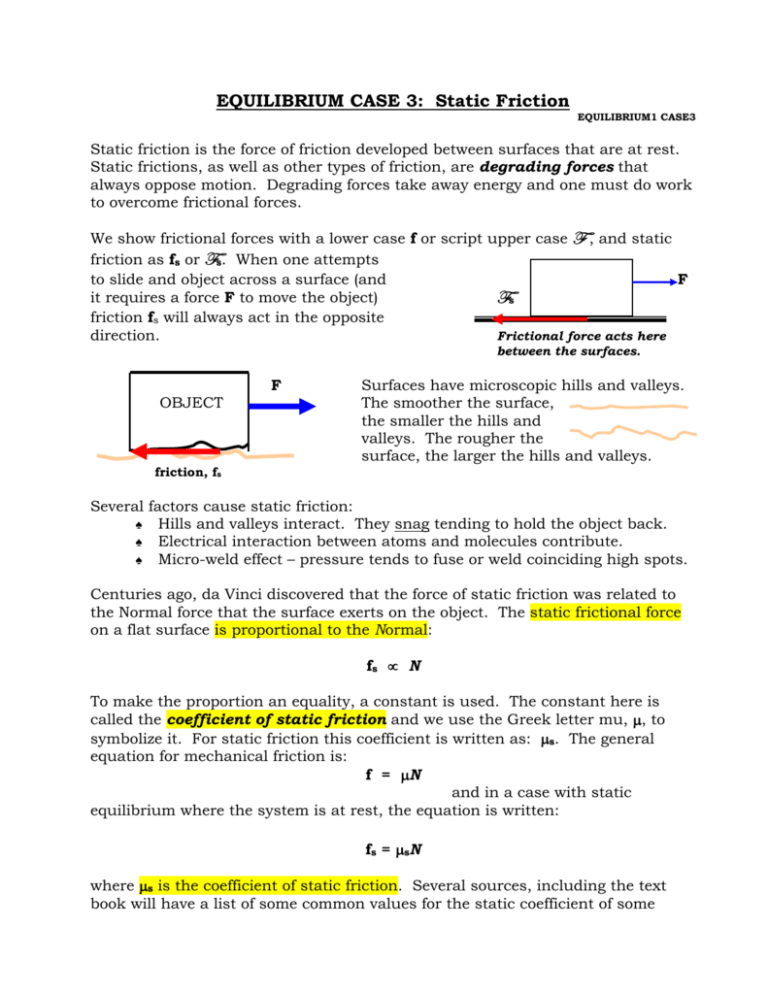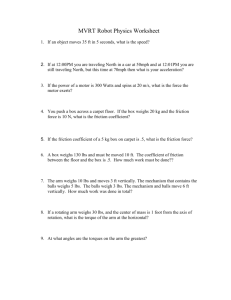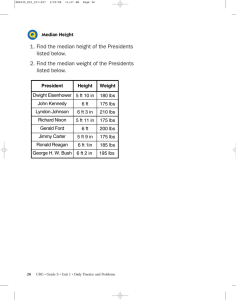EQUILIBRIUM CASE 3: Static Friction
advertisement

EQUILIBRIUM CASE 3: Static Friction EQUILIBRIUM1 CASE3 Static friction is the force of friction developed between surfaces that are at rest. Static frictions, as well as other types of friction, are degrading forces that always oppose motion. Degrading forces take away energy and one must do work to overcome frictional forces. We show frictional forces with a lower case f or script upper case F , and static friction as fs or Fs. When one attempts to slide and object across a surface (and F it requires a force F to move the object) Fs friction fs will always act in the opposite direction. Frictional force acts here between the surfaces. F OBJECT Surfaces have microscopic hills and valleys. The smoother the surface, the smaller the hills and valleys. The rougher the surface, the larger the hills and valleys. friction, fs Several factors cause static friction: ♠ Hills and valleys interact. They snag tending to hold the object back. ♠ Electrical interaction between atoms and molecules contribute. ♠ Micro-weld effect – pressure tends to fuse or weld coinciding high spots. Centuries ago, da Vinci discovered that the force of static friction was related to the Normal force that the surface exerts on the object. The static frictional force on a flat surface is proportional to the Normal: fs N To make the proportion an equality, a constant is used. The constant here is called the coefficient of static friction and we use the Greek letter mu, , to symbolize it. For static friction this coefficient is written as: s. The general equation for mechanical friction is: f = N and in a case with static equilibrium where the system is at rest, the equation is written: fs = sN where s is the coefficient of static friction. Several sources, including the text book will have a list of some common values for the static coefficient of some surfaces. These values are determined experimentally and for each set of surfaces in contact there is a specific coefficient. The values are pure numbers – no units are assigned to them. Examples: wood on wood: steel on steel: metal on wood rubber on dry concrete: s s s s = = = = 0.70 0.20 0.25 0.90 Note that: 0 s 1 Static frictional forces will have a maximum value for any set of surfaces. Beyond that point, motion will occur and the object can no longer be in static equilibrium. The maximum static frictional force is written as: fs (max) sN This is the definition of static friction we will use. The maximum force of static friction is equal to or greater than the product of the coefficient of static friction for the surfaces involved and the Normal force exerted by the surface on the object. Layout of vectors around a block: We lift the Normal vector to the cg. We y slide the forces F N and fs to the cg. y N F -x fs x -x fs F x forward pull on block friction holds back w w -y -y Normal arises from the surface, Weight vector from the cg. If we collapse a body down to Its cg, all the forces act at cg. Let’s look at an example of the same object in different circumstances. Consider a 100 lb crate sitting on a level floor. The coefficient of (static) friction for the two surfaces – the floor and the underside of the crate – is 0.6. We will examine several situations in which we increase the pull (F) on the crate. First we will pull with a force of 10 lbs. What happens? y N -x fs F = 10 lbs w = 100 lbs -y x Fy = 0 = N + (-)w N = w = 100 lbs The maximum frictional force is: fs(max) = sN Then fs(max) = 0.6(100 lbs) = 60 lbs, the greatest frictional force that can exist at 100 lbs. To break free from friction we must pull forward with a force greater than 60 lbs. We pull with a force of 10 lbs and the force of static friction is 10 lbs. Why? By Newton’s 3rd Law and because the crate is in equilibrium and Fx = 0. Fx = F – fs = 0, F = fs = 10 lbs. y N F = 20 lbs -x x fs w -y Next we pull forward with a force of 20 lbs. Friction pulls against the motion. Still in equilibrium we see: Fx = F – fs = 0, F = fs = 20 lbs. Bump the force of the pull to 50 lbs. This is still less N x than the 60 lb maximum static frictional force for the surfaces. No motion takes fs F = 50 lbs place. Equilibrium still exists and -x x F = fs = 50 lbs. y N fs w F = 60 lbs -x -y x Finally we match the maximum static frictional force with a pull of 60 lbs. w This is a special case when F = fs(max). -y At F = 60 lbs, the crate just wants to move. The crate is now in a state of impending motion. This state can only exist at fs(max). The crate is ready to “break away” from friction’s grip, but does not yet move. If we exert any force greater than fs(max), motion occurs and we have a resulting net force 0. If we have a Resultant 0, we are no longer in equilibrium. Now we must use F = ma (Newton’s 2nd Law) to solve the problem. If we are not in equilibrium, some unbalanced force will equal mass times acceleration. Let’s pull with a force of 70 lbs. The Fy = 0, since the crate is not moving up or down, but the Fx = ma. acceleration! y N = 100 lbs -x fs = 60 lbs F = 70 lbs x w = 100 lbs -y R = F – fs = 70 lbs – 60 lbs = 10 lbs. We have Fnet = 10 lbs = ma. (m = w/g) No more equilibrium, so now we solve for the acceleration: F = ma, a = F/m = F/w/g = 10 lbs/100lbs/32 ft/s2 = 3.2 ft/s2 3






